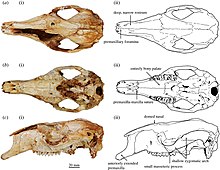Congruus is an extinct genus of macropod known from the Late Pleistocene of Australia. There are two species, Congruus kitcheneri, which was originally described as a species of Wallabia,[1][2] and Congruus congruus.[3] Specimens are known from Mammoth Cave, Western Australia, the Thylacoleo Caves (Nullarbor Plain) and the Naracoorte caves in South Australia.[2][3] Potential material is also known from Eastern Australia.[2] The morphology of the skull and limbs suggests that they were semi-arboreal browsers, moving slowly through trees, though they were larger than and not as specialised for climbing as living tree kangaroos.[2] They are thought to be members of the tribe Macropodini, and close relatives of the extinct genus Protemnodon.[4]
| Congruus Temporal range:
| |
|---|---|

| |
| Skull of Congruus kitcheneri | |
| Scientific classification | |
| Domain: | Eukaryota |
| Kingdom: | Animalia |
| Phylum: | Chordata |
| Class: | Mammalia |
| Infraclass: | Marsupialia |
| Order: | Diprotodontia |
| Family: | Macropodidae |
| Subfamily: | Macropodinae |
| Genus: | †Congruus McNamara, 1994 |
| Species | |
| |
References
edit- ^ Flannery TF. 1989A new species of Wallabia (Macropodinae: Marsupialia) from Pleistocene deposits in Mammoth Cave, southwestern Western Australia. Records of the Western Australian Museum 14, 299-307.
- ^ a b c d Warburton, Natalie M.; Prideaux, Gavin J. (March 2021). "The skeleton of Congruus kitcheneri , a semiarboreal kangaroo from the Pleistocene of southern Australia". Royal Society Open Science. 8 (3): rsos.202216, 202216. doi:10.1098/rsos.202216. ISSN 2054-5703. PMC 8074921. PMID 33959368.
- ^ a b McNamara JA. 1994 A new fossil wallaby (Marsupialia: Macropodidae) from the south east of South Australia. Records of the Western Australian Museum 27, 111-115.
- ^ Kerr, Isaac A. R.; Prideaux, Gavin J. (2022-07-03). "A new genus of kangaroo (Marsupialia, Macropodidae) from the late Pleistocene of Papua New Guinea". Transactions of the Royal Society of South Australia. 146 (2): 295–318. doi:10.1080/03721426.2022.2086518. ISSN 0372-1426. S2CID 250189771.